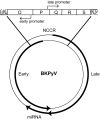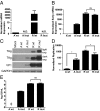miRNA regulation of BK polyomavirus replication during early infection
- PMID: 23630296
- PMCID: PMC3657827
- DOI: 10.1073/pnas.1301907110
miRNA regulation of BK polyomavirus replication during early infection
Abstract
Viral microRNAs (miRNAs) play an important role during infection by posttranscriptionally regulating both host and viral gene expression. However, the function of many viral miRNAs remains poorly understood. In this study, we investigated the role of the BK polyomavirus (BKPyV) miRNA in regulating virus replication. The function of the polyomavirus miRNA was investigated in archetype BKPyV, which is the transmissible form of the virus and thought to establish a persistent infection in the host urinary tract. In agreement with previous studies, we show that the BKPyV miRNA targets early mRNAs. Importantly, we show that the miRNA plays a significant role in limiting archetype BKPyV replication in a natural host cell model of infection. This regulation is accomplished through the balance of regulatory elements located within the noncoding control region that control early gene expression and miRNA expression before genome replication. We therefore provide evidence for a unique function of the polyomavirus miRNA that may have important implications for the mechanism of viral persistence.
Conflict of interest statement
The authors declare no conflict of interest.
Figures





Similar articles
-
Control of Archetype BK Polyomavirus MicroRNA Expression.J Virol. 2020 Dec 22;95(2):e01589-20. doi: 10.1128/JVI.01589-20. Print 2020 Dec 22. J Virol. 2020. PMID: 33115878 Free PMC article.
-
BK polyomavirus microRNA expression and sequence variation in polyomavirus-associated nephropathy.J Clin Virol. 2018 May;102:70-76. doi: 10.1016/j.jcv.2018.02.007. Epub 2018 Feb 12. J Clin Virol. 2018. PMID: 29518695
-
A Cell Culture Model of BK Polyomavirus Persistence, Genome Recombination, and Reactivation.mBio. 2021 Oct 26;12(5):e0235621. doi: 10.1128/mBio.02356-21. Epub 2021 Sep 2. mBio. 2021. PMID: 34473564 Free PMC article.
-
Host and viral RNA dysregulation during BK polyomavirus infection in kidney transplant recipients.Wiley Interdiscip Rev RNA. 2023 Jul-Aug;14(4):e1769. doi: 10.1002/wrna.1769. Epub 2022 Dec 5. Wiley Interdiscip Rev RNA. 2023. PMID: 36470265 Review.
-
Impact of BK Polyomavirus NCCR variations in post kidney transplant outcomes.Gene. 2024 Jun 30;913:148376. doi: 10.1016/j.gene.2024.148376. Epub 2024 Mar 13. Gene. 2024. PMID: 38490510 Review.
Cited by
-
JCPyV VP1 Mutations in Progressive MultifocalLeukoencephalopathy: Altering Tropismor Mediating Immune Evasion?Viruses. 2020 Oct 12;12(10):1156. doi: 10.3390/v12101156. Viruses. 2020. PMID: 33053912 Free PMC article. Review.
-
Mutational pressure by host APOBEC3s more strongly affects genes expressed early in the lytic phase of herpes simplex virus-1 (HSV-1) and human polyomavirus (HPyV) infection.PLoS Pathog. 2021 Apr 30;17(4):e1009560. doi: 10.1371/journal.ppat.1009560. eCollection 2021 Apr. PLoS Pathog. 2021. PMID: 33930088 Free PMC article.
-
Regulation of Virus Replication by BK Polyomavirus Small T Antigen.J Virol. 2023 Mar 30;97(3):e0007723. doi: 10.1128/jvi.00077-23. Epub 2023 Mar 14. J Virol. 2023. PMID: 36916919 Free PMC article.
-
Liquid Biopsy to Detect DNA/RNA Based Markers of Small DNA Oncogenic Viruses for Prostate Cancer Diagnosis, Prognosis, and Prediction.Front Oncol. 2020 Jul 8;10:778. doi: 10.3389/fonc.2020.00778. eCollection 2020. Front Oncol. 2020. PMID: 32733786 Free PMC article. No abstract available.
-
Role of Host and Pathogen-Derived MicroRNAs in Immune Regulation During Infectious and Inflammatory Diseases.Front Immunol. 2020 Jan 24;10:3081. doi: 10.3389/fimmu.2019.03081. eCollection 2019. Front Immunol. 2020. PMID: 32038627 Free PMC article. Review.
References
-
- Bartel DP. MicroRNAs: Genomics, biogenesis, mechanism, and function. Cell. 2004;116(2):281–297. - PubMed
-
- Ahsan N, Shah KV. Polyomaviruses and human diseases. Adv Exp Med Biol. 2006;577:1–18. - PubMed
-
- Moens U, Van Ghelue M. Polymorphism in the genome of non-passaged human polyomavirus BK: Implications for cell tropism and the pathological role of the virus. Virology. 2005;331(2):209–231. - PubMed
Publication types
MeSH terms
Substances
Grants and funding
LinkOut - more resources
Full Text Sources
Other Literature Sources

